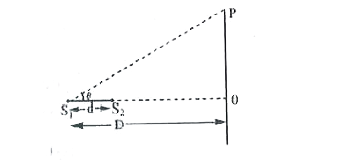In the figure shown, a screen is placed normal to the line joining the two point coherent sources S1andS2. The interference pattern consists of concentric circles.

(a)Find the radius of the nth bright ring.
(b) If d=0.5 mm, λ=5000Å and D=100 cm, find the radius of the closest second bright ring.
(c) Also, find the value of n for this ring.
The correct Answer is:A, B, C, D
(a)∵Δx=dcosθ
cosθ=1−θ22 (when θ is small)
∴Δx=d(1−θ22)
=d(1−y22D2)

For nth maxima Δx=nλ
∴ y=radius of nth bright ring.
=D√2(1−(nλd)).
(b) d=1000λ
At O, Δx=d=1000λ
i.e. at O, 1000 th order maxima is obtained.
Substituting n=998 in,
y=D√2(1−(nλd))
We get the radius of second closest ring
r=6.32 cm
(c) n= 998
Topper's Solved these Questions
- INTERFERENCE AND DIFFRACTION OF LIGHTBook:DC PANDEY ENGLISHChapter:INTERFERENCE AND DIFFRACTION OF LIGHTExercise:Level 2 Comprehensionn Based
Explore 4 Videos
- GRAVITATIONBook:DC PANDEY ENGLISHChapter:GRAVITATIONExercise:All Questions
Explore 135 Videos
- MAGNETIC FIELD AND FORCESBook:DC PANDEY ENGLISHChapter:MAGNETIC FIELD AND FORCESExercise:Medical entrance s gallery
Explore 59 Videos
Similar Questions
A young's double slit apporatus is immersed in a liquid of refractive index 1.33.It has slit separation of 1 mm and interference pattern is observed on the screen at a distance 1.33 m from plane of slits.The wavelength in air is 6300Å
Calculate the fringe width.
View SolutionAn infinite number of particles each of mass m are placed on the positive X-axis of 1m,2m,4m,8m,... from the origin. Find the magnitude of the resultant gravitational force on mass m kept at the origin.
View SolutionA long wire carries a steady curent . It is bent into a circle of one turn and the magnetic field at the centre of the coil is B. It is then bent into a circular loop of n turns. The magnetic field at the centre of the coil will be
View SolutionIn the figure shown, a screen is placed normal to the line joining the two point coherent sources S1andS2. The interference pattern consists of concentric circles.

(a)Find the radius of the nth bright ring.
(b) If d=0.5 mm, λ=5000Å and D=100 cm, find the radius of the closest second bright ring.
(c) Also, find the value of n for this ring.
View SolutionIn figure, a screen is placed normaol to the line joining the two point coherent sources S1 and S2. The interference pattern consists of concentric circles.

Find the radius of the nth bright ring
View SolutionIn figure, a screen is placed normaol to the line joining the two point coherent sources S_(1) and S_(2) . The interference pattern consists of concentric circles. If d = 0.5 mm, lambda = 5000 Å and D - 10 cm , find the value of n for the closest second bright ring.
View SolutionIn figure, a screen is placed normaol to the line joining the two point coherent sources S_(1) and S_(2) . The interference pattern consists of concentric circles. Also, find the value of radius for this ring.
View SolutionTwo coherent monochromatic point sources S1 and S2 are placed in front of an infinite screen as shown in figure. Wavelength of the light emitted by both the sources is zero. Initial phase difference between the sources is zero.

Initially S1S2=2.5λ and the number of bright circular rings on the screen in n1. if the distance S1S2 is increased and made 5.7λ, the number of bright circular rings becomes n2. the difference n2−n1 is
View SolutionLight of wavelength λ from a point source falls on a small circular rings around a central bright spot are formed on a screen beyond the obstacle The distance beetween the screen and obstacle is D. Then, the condition for the formation of rings, is
View SolutionTwo monochromatic coherent sources of wavelength 5000 Å are placed along the line normal to the screen as shown in the figure.
(a) Determine the condition for maxima, at the point P.
(b)Find the order of the central bright fringe if d = 0.5 mm, D = 1 m.

View SolutionIn the arrangement shown, a screen is placed normal to the line joining the two point coherent sources S1 and S2. The interference pattern consist of concentric circles. λ is the wavelength of light (D>>d).

The phase difference of the interfering light at point P is
View SolutionIn the arrangement shown, a screen is placed normal to the line joining the two point coherent sources S1 and S2. The interference pattern consist of concentric circles. λ is the wavelength of light (D>>d).

The radius of the nth bright ring is
View SolutionIn the arrangement shown, a screen is placed normal to the line joining the two point coherent sources S1 and S2. The interference pattern consist of concentric circles. λ is the wavelength of light (D>>d).

if d = 0.5 mm, λ=5000A∘,D=1m, at the point 'O' lying on the intersection of screen and the line joining the sources, the order of the fringe formed is
View SolutionIn the arrangement shown ,a screen is placed normal to the joining the two point coherent sources S1andS2 .The interference pattern consists circles. λ is the wavelength of light (D>>d).

The radius of the nth bright ring is
View SolutionIn the arrangement shown ,a screen is placed normal to the joining the two point coherent sources S1andS2 .The interference pattern consists circles. λ is the wavelength of light (D>>d).

If d=0.5mm,λ=5000A0 , D = 1 m , at the point .O. lying on he intersection of screen and the line joining the sources , the orfer of the fringe formed is
View Solution

